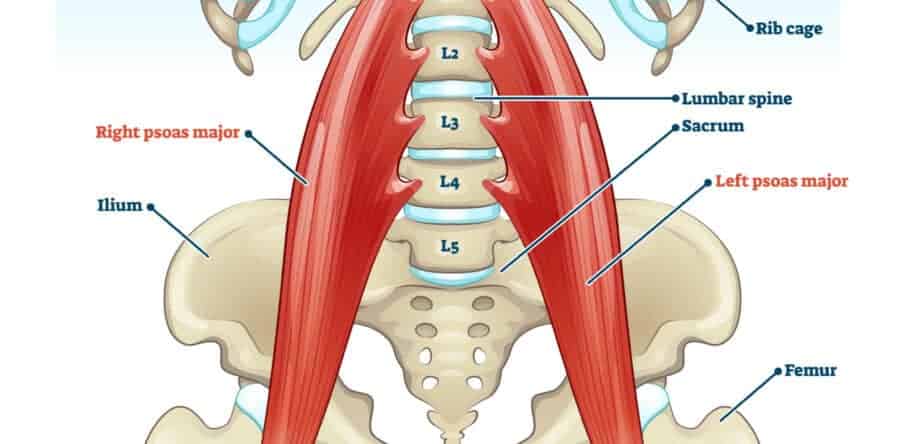Psoas Muscle: Rehab Pilates

If there is one muscle that deserves the title of “jack of all trades” in our body, it is the psoas. Running on either side of the spine, the psoas is one of the only 3 muscles that attach the spine directly to your legs. It is also one of the most fascinating and important muscles in the human body- physically and emotionally. It influences a healthy and balanced posture and is associated with our freedom of movement of the lower body. Moreover, it is also linked with our breathing and with different systems in our abdomen and pelvis. Due to it being highly innervated and so closely linked to vital organs through its fascial connections, it is also set to be important for our emotional health. In this blog, we help you identify the health of your psoas and exercises you can do to keep it strong.
Anatomy
The Psoas is a long fusiform muscle which is a combination of the psoas major and minor, on either side of the vertebral column. In a lot of people, psoas minor is a tendon due to evolution from all-fours to bipedal. Thus, when we talk of the psoas, we are talking of the psoas major.
The fibers of the muscle have an extensive origin. It connects the transverse processes of the lumbar vertebrae, and the vertebral bodies and the intervertebral discs of the lower back all the way up to T12, where your lower ribs begin. Without attaching to the pelvis, the psoas runs inferolaterally through it and attaches anteriorly to the lesser trochanter of the femur. The muscle fibers share the same attachment to the femur as the iliacus muscle, and together they are known as the iliopsoas.
The origin of the iliacus is on the inside of the pelvic rim, and it assists hip flexion at the pelvis. However, the function of psoas is different from the iliacus.

Relations
Anatomically, the psoas lies very close to the diaphragm, quadratus lumborum, the pelvic floor, the inferior vena cava, the abdominal aorta, the kidneys, the ureters, and the gonadal vessels. The sympathetic trunk and aortic lymph nodes are also located medially to it. Because of its location, the roots of the lumbar plexus, the collection of nerves arising from the lumbar spine are embedded in the psoas and emerge from its lateral end as branches.
In the thigh, it contributes to the floor of the femoral triangle, or the region of the groin which is indented when we abduct or flex the leg. The iliopsoas tendon lies deep to the fascia lata, sartorius, rectus femoris and deep femoral artery. It is separated from the joint capsule of the hip by the iliac bursa. Pectineus and the femoral vein lie medially while the femoral nerve lies laterally to the it.
Function of the Psoas Muscle
The psoas muscle is amongst the most significant muscles that overlie the vertebral column. As mentioned earlier , the function of the psoas muscle is to connect the upper body to the lower body. But it does more than that.
- With its fascial connections it links the outside to the inside, the appendicular to the axial skeleton, and the front to the back.
- Combined with the iliopsoas, it is assists in flexion of the hip joint.
- It also controls eccentric hip extension.
- It acts as a stabilizer of the femoral head in the acetabulum.
- Through its fascial connection, the psoas influences the respiratory function and the functional relationship between the diaphragm and the pelvic floor.
Dysfunction
We all know that an inactivity or overactivity, both can cause dysfunction. When your body is habitually positioned in a certain posture, often for hours on end, this posture becomes standard. Your musculature and connective tissues will adapt to this shape.
Psoas pain can be triggered by
- a sedentary lifestyle, sitting for long hours,
- injury to the muscle,
- overactivity because of intense cycling or mountain climbing (as it requires constant hip flexion),
- any inflammatory condition like arthritis or disease in the visceral organs, or
- anxiety and mood disorders due to its connection with the sympathetic nervous system
Effect of psoas dysfunction
The effect of an imbalanced psoas muscle on the lower back is direct and immediate. In its dysfunction, the psoas affects hip extension. Resulting in either an exaggerated lordosis or an anterior pelvic tilt. This can cause the following symptoms:
- Clinically, psoas pain presents symptoms similar to low back pain viz. pain in the groin and pelvis, radiating towards knee.
- It affects hip flexion, hence difficulty in walking.
- There is difficulty in sustaining a fully erect posture.
- It can cause a restriction in the movement of the diaphragm and thus shallow breathing and restriction in thoracic extension.
- A psoas spasm may lead to compression of the lumbar spine with shearing stress of the lumbosacral joint.
- Since there are two separate psoai, they can be of different lengths. An imbalance in the psoas can lead to spinal misalignment.
Tightness or imbalance in the tone of the psoas can cause other (often overlooked) issues too. These include: difficulty focusing, sitting still or relaxing, irritability, fatigue, problems falling asleep or sleeping well and digestive issues.
Rehab for the Psoas
The psoas is one of the strongest muscles in your body, and the effect and influence of it on the internal structure of your body is significant. Maintaining a strong psoas is important to overall wellbeing. Pilates, with its focus on the smaller muscles, while encompassing the whole body is the best for its rehab, as well as for preventing dysfunction.
When the psoas is weak, the hip flexors become overactive and the pelvis is anteriorly tilted. To balance it out, we need to reactivate the psoas and reestablish its role in controlling eccentric hip extension.
We focus first on relaxing the muscle to subdue the pain. Then we move on to strengthening the inner core, improving abdominal control and glute strength. Then we move to lenthening of hip flexors and working on improving eccentric hip extension control.
Check out the video below for some exercises to strengthen this muscle. Join our classes to get the maximum results.
